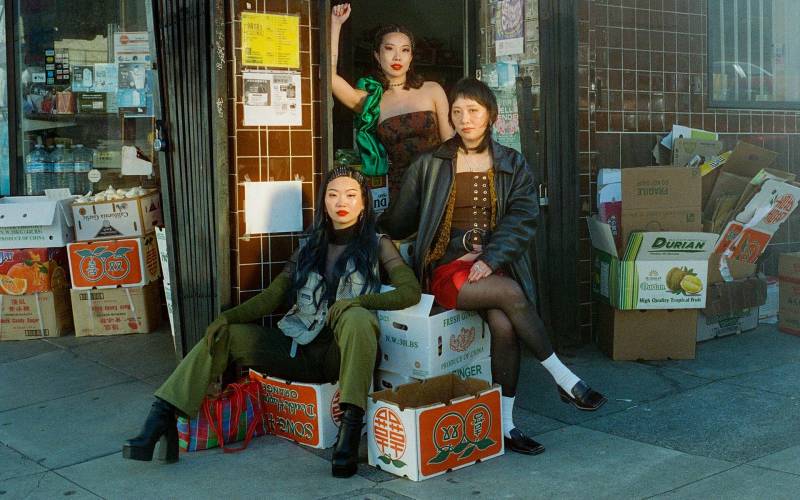Entre chien et loup
2015 - Installation (Installation)
170 x 150 cm
Gaëlle Choisne
Entre Chien et Loup is an installation incorporating a variety of media: rubber, discs, feathers and confetti that the artist weaves, sews and glues together. Influenced by Mike Kelley’s Memory Ware series, the artist creates an object-memory from found materials. The found objects used recall the artist’s mother – it is somehow her portrait, her cape-. Choisne’s mother was born in Haiti and migrated to France with her husband. She landed in Cherbourg, Brittany where she became “the foreigner” by her country of origin and her skin color. The work too is a tribute to the artist Sun Ra, his costumes and the Afrofuturism movement of which he is an emblematic figure. In this work, Choisne presents her mother as a figure of Afrofuturism. The expression Entre Chien et Loup refers to the moment when in dim light, one can no longer distinguish between a dog and a wolf. Here, in references to the figures that populate the installation -the artist’s mother and Sun Ra- they become indistinguishable.
Gaelle Choisne’s artistic practice is an address to the world’s disorder. Without any pessimism or catastrophism, it mirrors the complexity of contemporary times trough multiple medias and burgeoning installations. Sculptures, images and referential systems are imbricatedhere and merge in opulent environments, inhabited by the gestures of the artist. Between occult fables and objective sciences, from the Caribbean to European literary traditions, she navigates through imaginaries as composite as the techniques which give them shape: casting, firing, printout, suspension, collage, torsion, extraction. The artist’sinterest in the work process is often left apparent in installations-sculptures-images whose fringes are always experimental. As if, lost in apermanent gestation, her work could not obtain a permanent status in regard to its arrangement, form and reproducibility. Thus, itspertinence is to be found in this discontinuous transformation, this systematic reversing of media, techniques and surfaces. This practice of becoming, in which meaning can arise only through perpetual movement, operates through palpation and seems always agitated,marked by an organic energy. One could say that the hand, which always fiddles, displaces and modifies plays a kind of drag, a falselynaïve craftsmanship. (Text by Thomas Conchou)
Colors:
Related works sharing similar palette

© » ARTS EQUATOR
Veteran Artists Team Up with Younger Generation at ‘Wild Eye’ Exhibition (via The Irrawady) | ArtsEquator Thinking and Talking about Arts and Culture in Southeast Asia Articles September 12, 2018 YANGON — Veteran modernists and younger generations have teamed up to exhibit their works together in Yangon...

© » KADIST
Prabhakar Pachpute
2017Prabhakar Pachpute was born in 1986 and raised in Chandrapur (Maharashtra), India, a place known as ‘The City of Black Gold’, where his family has worked for three generations in one of the oldest mines in the country...

© » LE MONDE
« Les musées doivent pleinement jouer leur rôle dans le débat écologique » nav_close_menu Offrir Le Monde F ace au dérèglement climatique et alors que s’est achevée mercredi 13 décembre la COP28 , les musées, institutions ancrées dans la vie de la cité, sont à un tournant de leur histoire, contraints de réinventer leurs modes d’action, de pensée et de fonctionnement...

© » HYPERALLERGIC
Archaeologists Find Evidence of Hallucinogenic Drug in Ancient Rome Skip to content A bust of Emperor Trajan surrounded by black henbane seends and flowers and a femur discovered by archaeologists (edit Valentina Di Liscia/ Hyperallergic ) Two new archaeological finds suggest Roman subjects at the northern edge of the ancient empire used a hallucinogenic and poisonous plant called black henbane, the effects of which were described by Greek philosopher Plutarch as “not so properly called drunkenness” but rather “alienation of mind or madness.” Dutch zooarchaeologists Maaike Groot and Martijn van Haasteren and archaeobotanist Laura I...

© » LE MONDE
Au Quai Branly, les pleureuses revisitées de Myriam Mihindou Cet article vous est offert Pour lire gratuitement cet article réservé aux abonnés, connectez-vous Se connecter Vous n'êtes pas inscrit sur Le Monde ? Inscrivez-vous gratuitement Article réservé aux abonnés Vue de l’exposition « Ilimb, l’essence des pleurs », de Myriam Mihindou, au Quai Branly, à Paris...

© » KQED
A Next-Generation Lunar New Year Party in Oakland | KQED Skip to Nav Skip to Main Skip to Footer upper waypoint Food A Next-Generation Lunar New Year Party in Oakland Alan Chazaro Feb 12 Save Article Save Article Failed to save article Please try again Email Yăng Shēng, a multimedia project launched by Hanna Chen (left), aims to bring "third culture" children of immigrants from Asian diasporas together in the Bay Area...

© » ARTS EQUATOR
Ombak Potehi’s "Kisah Pulau Pinang: The Penang Story": A Slice of Malayan History | ArtsEquator Thinking and Talking about Arts and Culture in Southeast Asia Articles John K August 30, 2018 By Akanksha Raja (620 words, four-minute read) Ombak Potehi is Ombak Ombak Art Studio’s glove puppet theatre group established in 2015, consisting of young people – all under 30 – producing and performing puppet theatre, having been trained by experts from Penang’s Beng Geok Hong Puppet Troupe...













